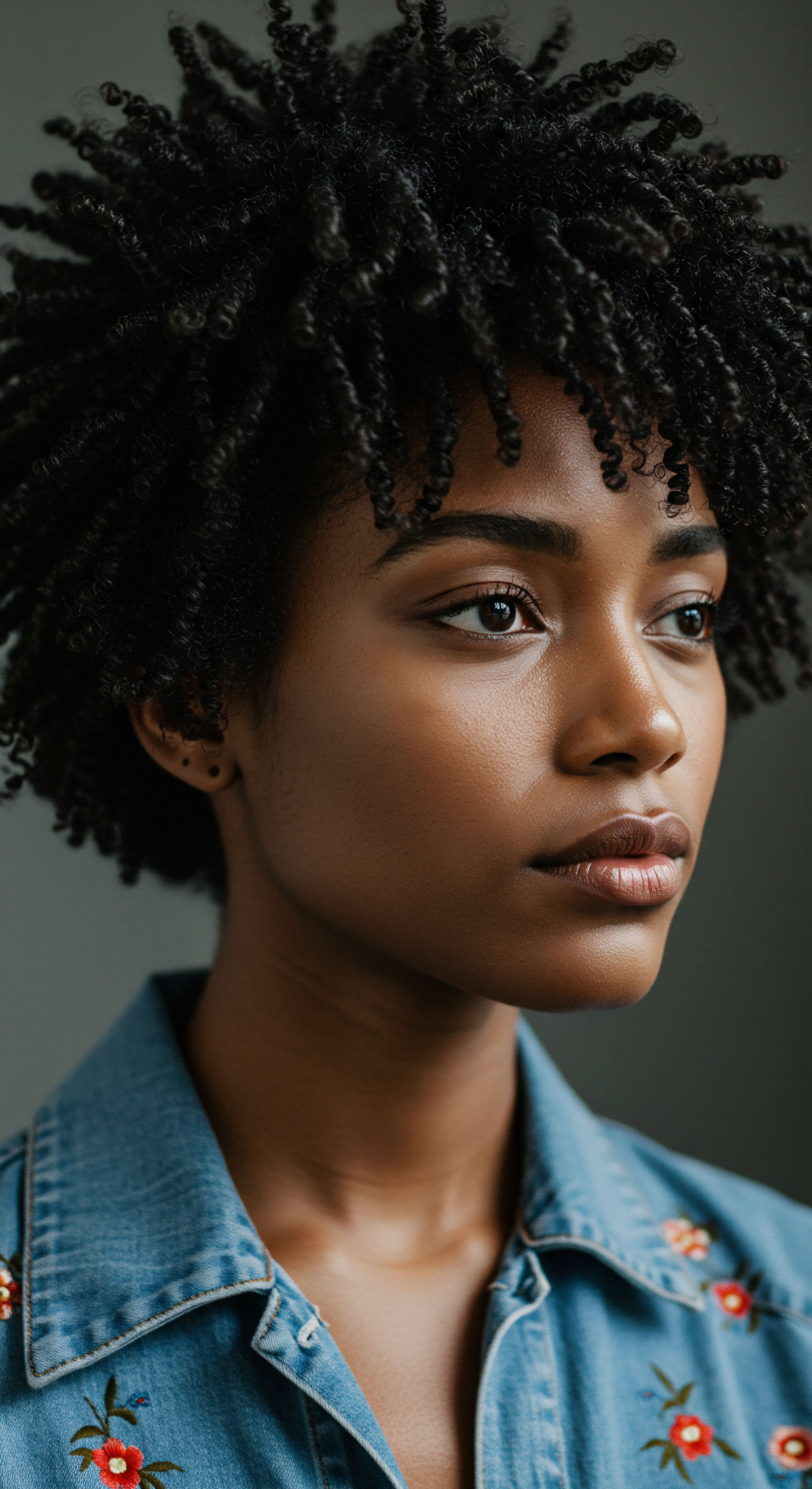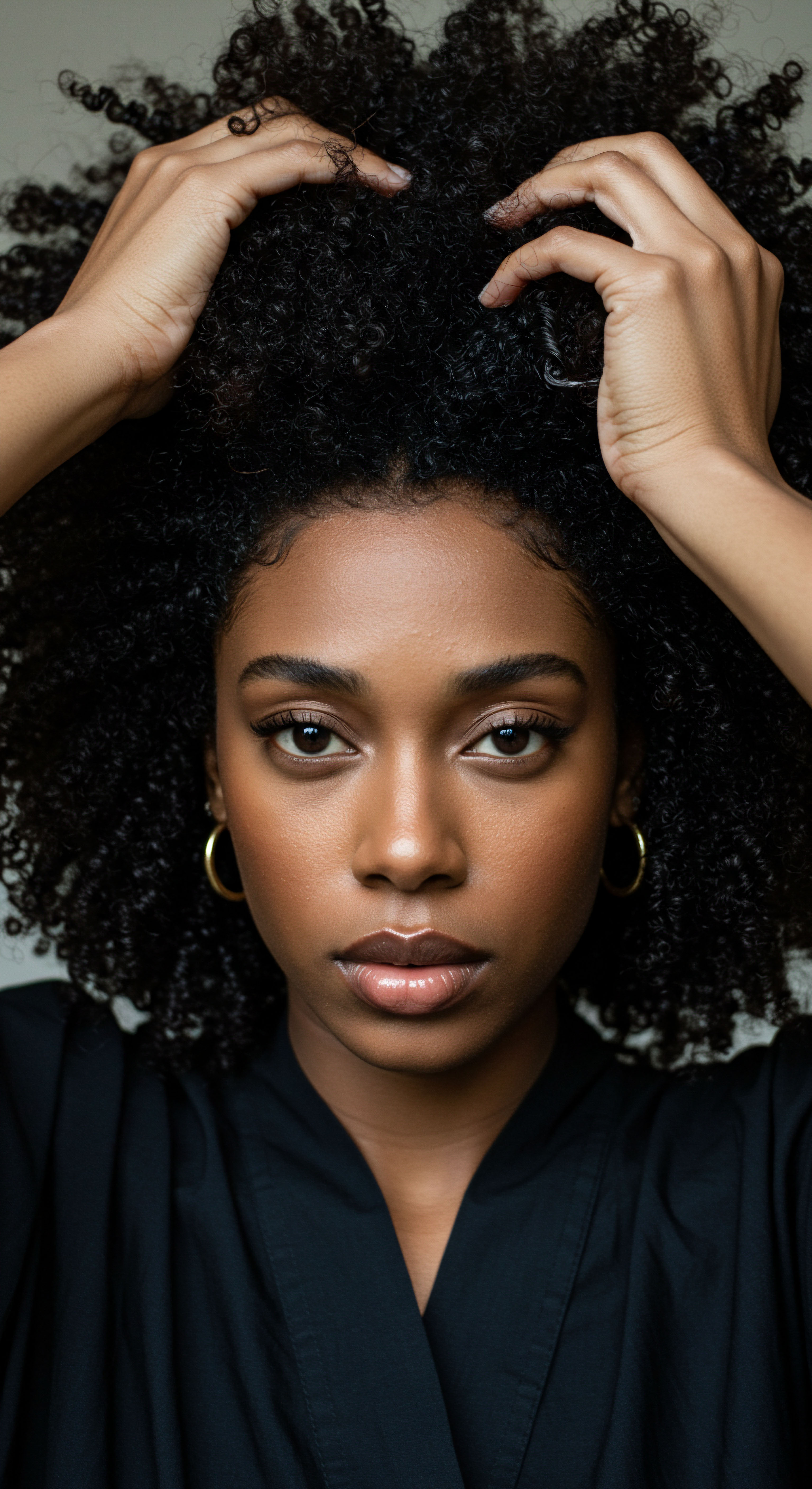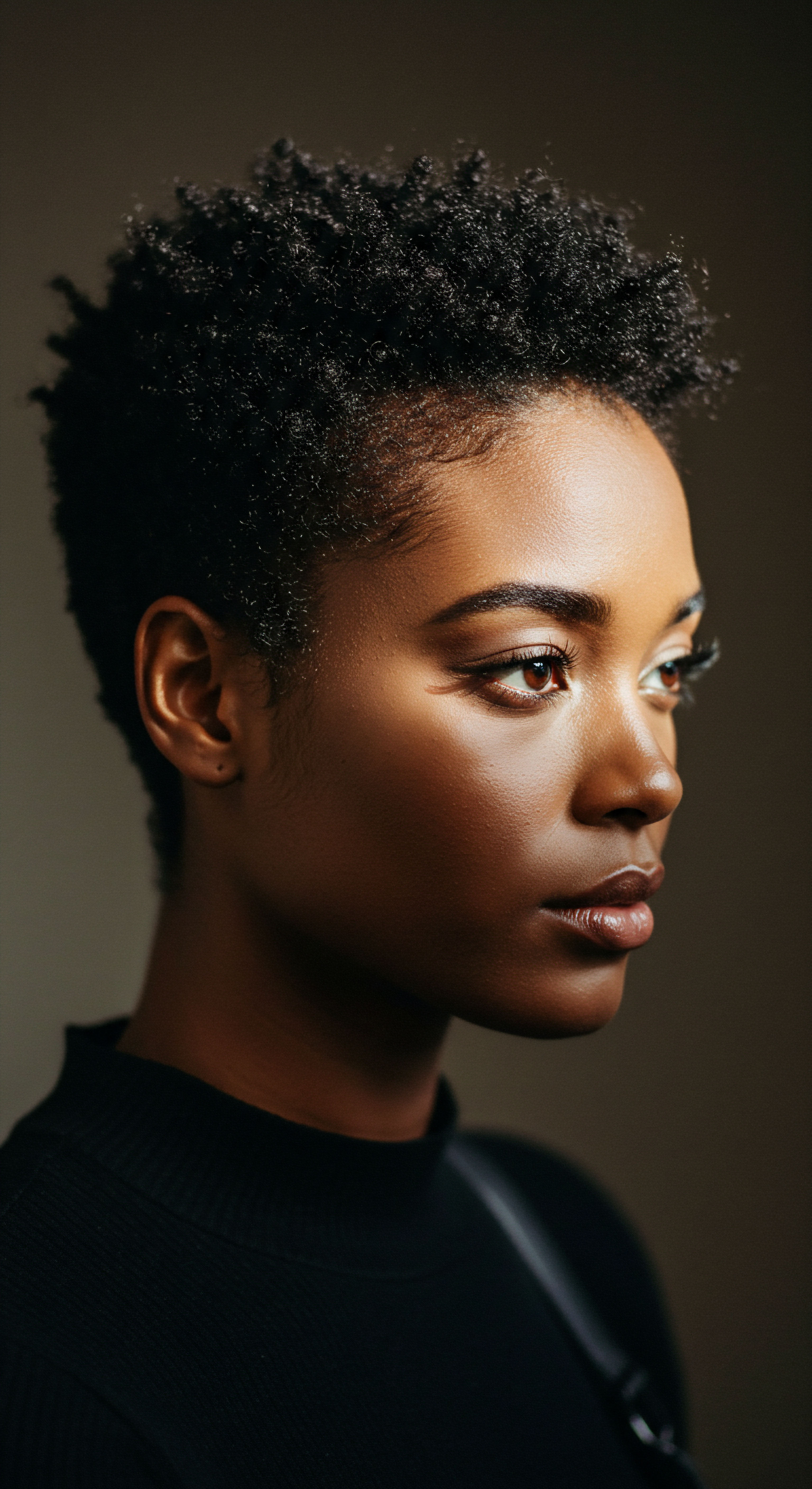
Roots
In the quiet hours of slumber, as the world settles into repose, a silent, yet profound, conversation takes place between our textured strands and the surfaces upon which we rest. It is a dialogue often overlooked, a subtle interplay of physics and biology that shapes the very vitality of our hair. For those with coils, curls, and waves, this nightly interaction holds particular weight, for the unique architecture of textured hair renders it both splendidly resilient and singularly susceptible to the unseen forces of friction and moisture displacement.
Consider the gentle caress of a breeze or the rhythmic beat of a drum; each has its distinct impact. So too does the chosen fabric of our nightly sanctuary, subtly influencing the very foundation of our hair’s well-being.

Hair’s Outer Shield and Its Vulnerability
The outermost layer of each hair strand, known as the Cuticle, serves as a protective armor. For textured hair, this cuticle layer naturally possesses a more lifted or raised structure compared to straight hair. Think of it as a series of tiny, overlapping scales, much like shingles on a roof. While this structure contributes to the beautiful volume and definition we admire, it also means that these scales are more prone to catching, lifting further, or even chipping away when subjected to constant mechanical stress.
During sleep, as we shift and turn, our hair rubs against the pillowcase. This seemingly innocuous contact, repeated night after night, can lead to a gradual disruption of these delicate cuticle scales. A compromised cuticle cannot effectively shield the inner layers of the hair, leaving them vulnerable to external aggressors and internal dehydration.

The Cortex Core Strength and Moisture Retention
Beneath the cuticle lies the Cortex, the heart of the hair strand, responsible for its strength, elasticity, and pigment. The cortex holds the majority of the hair’s moisture. When the cuticle is damaged by friction, its ability to seal in this vital hydration diminishes significantly. Water, which is essential for the hair’s suppleness and health, can then escape more readily, leading to dryness, brittleness, and a greater propensity for breakage.
A well-hydrated cortex means a resilient strand, capable of withstanding daily styling and environmental factors. Conversely, a parched cortex loses its pliability, becoming stiff and fragile.
The integrity of the hair’s cuticle directly impacts the cortex’s ability to retain essential moisture, a critical factor for textured hair health.

Porosity and Sleep Surfaces
Hair porosity describes the hair’s capacity to absorb and retain moisture, a characteristic primarily determined by the state of the cuticle.
- High Porosity Hair ❉ This hair type has a cuticle with more open or raised scales. It readily absorbs water but also loses it just as quickly, leading to dryness and frizz. Such hair often feels rough to the touch.
- Low Porosity Hair ❉ This hair type features tightly closed cuticle scales. It resists moisture absorption initially but holds onto it well once absorbed. It may feel smooth but can be challenging to moisturize.
The sleep surface plays a direct role in how hair, particularly textured hair, manages its moisture. Rougher fabrics, like conventional cotton, are known to absorb moisture from the hair, effectively drawing away natural oils and applied products. This absorption can exacerbate dryness for all hair types, but especially for textured hair which is already prone to dehydration due to its structural characteristics. Conversely, smoother surfaces help to preserve the hair’s natural moisture balance by minimizing this absorption.

Scalp Health Connection
While the direct impact of sleep surfaces is often discussed in relation to the hair strands themselves, the scalp also feels the effects. A compromised hair cuticle can lead to increased tangling and breakage, which in turn can place undue stress on the hair follicles embedded in the scalp. Furthermore, certain sleep surfaces, particularly those that are less breathable or absorb moisture, can create an environment conducive to scalp dryness or irritation. A healthy scalp is the foundation for healthy hair growth, and any factor that disrupts its equilibrium can indirectly affect the vitality of the strands that emerge.

Ritual
Having grasped the underlying principles of how sleep surfaces interact with our hair’s delicate structure, we now turn our attention to the purposeful actions we can take. This involves moving from theoretical understanding to practical wisdom, transforming nightly repose into a period of genuine care. The quiet moments before sleep offer a unique opportunity to protect and nurture our coils and curls, preparing them for the morning with intention and gentleness. This shift from passive observation to active guardianship reshapes our approach to hair wellness, allowing us to cultivate serene strands.

The Silk and Satin Revelation
The widespread discussion around silk and satin pillowcases for hair health is not without merit. These materials stand in stark contrast to conventional cotton, which, despite its breathability, possesses a surface that can be surprisingly abrasive to hair.
The difference lies in their respective properties ❉
- Silk ❉ A natural protein fiber, silk boasts an incredibly smooth surface with a low coefficient of friction. This means hair glides over it with minimal resistance, significantly reducing mechanical stress, tangling, and breakage. Beyond its smoothness, silk is less absorbent than cotton, allowing hair to retain its natural oils and moisture.
- Satin ❉ While often confused with silk, satin refers to a type of weave, not a fiber. Satin can be made from various materials, including silk, but often comprises synthetic fibers like polyester. While synthetic satin offers a smoother surface than cotton and can reduce friction, it generally lacks silk’s breathability and moisture-retaining properties.
The “slip” factor of silk and satin is a key benefit. When hair encounters a rough surface like cotton, the cuticle scales can lift, leading to friction that causes frizz, snags, and eventually, breakage. The smooth glide provided by silk or quality satin helps keep the cuticle layers flat and undisturbed, preserving the hair’s natural sheen and structural integrity.

Bonnets, Scarves, and Pillowcases ❉ Which One for You?
The choice of sleep protection depends on individual preferences, hair length, and styling needs. Each option serves the overarching goal of reducing friction and maintaining moisture.
Consider these options ❉
- Silk or Satin Pillowcases ❉ These are a foundational choice for many. They are particularly beneficial for those who find head coverings uncomfortable or who prefer minimal nighttime manipulation. They offer a continuous, gentle surface for the hair to rest upon, regardless of sleep position.
- Bonnets and Scarves ❉ These provide a direct, encompassing shield for the hair. A silk or satin bonnet or scarf keeps all strands contained, minimizing exposure to friction and helping to seal in moisture. They are especially useful for preserving intricate styles, curls, or braids overnight. The history of head coverings for Black women, from the tignon laws to their contemporary role in beauty rituals, highlights their cultural significance and protective function.
When selecting a bonnet or scarf, look for soft, breathable materials like silk or satin. The fit should be secure enough to stay on throughout the night without being too tight, which could cause tension on the hairline. For those with longer or very voluminous hair, a larger bonnet might be more appropriate to avoid compression.
Choosing a smooth sleep surface or hair covering is a deliberate act of care, shielding textured strands from nightly friction and moisture loss.

Pre-Sleep Hair Preparation
Beyond the sleep surface itself, intentional preparation before bed can greatly amplify the benefits.
This involves a few gentle steps ❉
- Moisture Application ❉ Lightly misting hair with water or a hydrating leave-in conditioner before bed can replenish moisture lost throughout the day. Following this with a light oil or cream can help seal in that hydration, providing a protective barrier against dryness.
- Gentle Detangling ❉ Using fingers or a wide-tooth comb, gently detangle hair from ends to roots. This prevents knots from tightening overnight, which can lead to breakage in the morning.
- Protective Styling for Sleep ❉ Creating a loose protective style minimizes friction between individual strands and against the pillow. A “pineapple” (gathering hair loosely on top of the head with a soft scrunchie) is popular for curls, preserving definition. Loose braids or twists can also protect hair length and reduce tangles. Sleeping with wet hair can lead to increased friction and potential damage, so ensuring hair is mostly dry is often advised.

The Morning After
The gentle rituals of the night extend into the morning. Upon waking, the aim is to minimize manipulation. Carefully remove bonnets or scarves.
For hair styled in a pineapple or braids, gently release the hold and allow the curls to settle naturally. A light mist of water or a curl refresher can reactivate curls without requiring extensive re-styling, preserving the hair’s health and definition achieved through thoughtful nighttime care.

Relay
As we deepen our understanding of sleep surfaces and textured hair, the conversation extends beyond immediate impact to a more profound, interconnected view. This involves examining the subtle biophysical realities, tracing the rich cultural legacies that shape our hair care practices, and acknowledging the broader environmental and psychological influences at play. It is a nuanced exploration, inviting us to consider hair health not as an isolated phenomenon, but as a dynamic interplay of science, heritage, and personal well-being.

The Biophysics of Friction and Hair Fiber
At a microscopic level, the interaction between hair and a sleep surface is a study in tribology – the science of interacting surfaces in relative motion. Hair fibers, especially those with textured patterns, possess a unique surface topography due to their cuticle scales. When these scales rub against a rough surface, such as cotton, the friction generated is considerable. This mechanical stress can lead to the lifting, chipping, or even removal of cuticle cells, compromising the hair’s structural integrity.
Research indicates that the coefficient of friction for hair fibers can vary significantly based on surface treatment and environmental conditions. For instance, studies on hair fibers show that those retaining their natural sebum or treated with conditioning products exhibit initial coefficients of friction at least 25% lower than those stripped of sebum. This suggests that maintaining hair’s natural lubrication and employing conditioning agents prior to sleep can mitigate the damaging effects of friction, regardless of the sleep surface. Furthermore, continuous attrition of hair fibers against each other or external surfaces can damage the cuticle, impacting hair’s ability to slide smoothly and increasing susceptibility to tangling.
A study published in the Journal of Cosmetic Science (2008) by Dr. Trefor Evans, though focused on chemical and heat damage, underscores the broader principle that external forces significantly increase hair porosity and moisture loss. While not directly about sleep surfaces, this research highlights how physical disruption to the cuticle, akin to the friction from a rough pillowcase, directly compromises the hair’s ability to retain hydration, making it more vulnerable to further damage. This insight allows us to infer the direct link between sleep surface friction and heightened hair vulnerability.
| Material Type Cotton |
| Surface Texture Rough, fibrous |
| Moisture Absorption High |
| Friction Coefficient High |
| Hair Impact Increased frizz, breakage, dryness, cuticle damage |
| Material Type Synthetic Satin |
| Surface Texture Smooth, slick |
| Moisture Absorption Moderate |
| Friction Coefficient Lower than cotton |
| Hair Impact Reduced frizz, some breakage prevention, can trap heat |
| Material Type Mulberry Silk |
| Surface Texture Very smooth, natural protein |
| Moisture Absorption Low |
| Friction Coefficient Lowest |
| Hair Impact Significant frizz and breakage reduction, moisture retention, cuticle preservation, breathable |
| Material Type Silk offers the most beneficial properties for textured hair health due to its minimal friction and low moisture absorption. |

Cultural Echoes of Nighttime Hair Care
The practice of protecting hair during sleep is not a modern invention; it echoes through generations and across continents, particularly within communities with rich traditions of textured hair care. For many African cultures, hair was, and remains, deeply symbolic—a conduit for spiritual connection, an indicator of social status, and a canvas for artistic expression. Nighttime rituals were integral to maintaining these cherished styles and the health of the hair itself.
Historically, enslaved Africans in the diaspora, stripped of their traditional tools and practices, found resourceful ways to protect their hair, often using whatever materials were available, including rudimentary head coverings. This adaptability underscores a profound understanding of hair’s vulnerability and the persistent drive to preserve it. The contemporary use of bonnets and scarves, especially within Black communities, carries this legacy forward, serving not only a practical purpose but also acting as a quiet affirmation of heritage and self-care. These practices represent a continuous thread of wisdom, passed down through matriarchal lines, safeguarding hair and cultural identity through the night.

How Do Environmental Factors Intersect with Sleep Surfaces?
The environment of our sleeping space also plays a role in the efficacy of sleep surfaces. Humidity levels, for example, influence hair’s moisture content. In dry climates, a highly absorbent pillowcase can compound dehydration, drawing away precious water from already thirsty strands. Conversely, in humid environments, while moisture might be abundant, excessive friction can still lead to hygral fatigue – the weakening of hair from repeated swelling and contraction due to water absorption and loss.
A sleep surface that minimizes friction and allows for balanced moisture exchange can act as a buffer against these environmental extremes. The breathability of materials also matters. Synthetic fabrics, while smooth, can sometimes trap heat and moisture against the scalp, potentially leading to discomfort or even contributing to scalp issues over time. Natural fibers like silk, with their inherent temperature-regulating properties, allow for better air circulation, contributing to a more balanced scalp environment.

The Psychological Dimensions of Hair Health
Beyond the tangible benefits of reduced breakage and improved moisture, the act of caring for one’s hair at night holds a quiet psychological significance. These rituals, whether wrapping hair in a silk scarf or simply resting on a smooth pillowcase, contribute to a sense of well-being and self-respect. For individuals with textured hair, whose strands have often been subjected to societal pressures and misrepresentations, intentional hair care can be a powerful act of affirmation.
It is a moment of quiet rebellion against narratives that devalue natural hair, reinforcing a connection to one’s authentic self and cultural lineage. This nightly act of protection becomes a small, yet mighty, contribution to overall personal harmony.

Reflection
The nightly journey into sleep offers more than just rest for the body; it presents a profound opportunity for hair’s restoration and protection. The surface upon which our textured strands lie holds a quiet power, capable of either enhancing their natural vitality or slowly diminishing it. By choosing surfaces that honor the unique architecture of curls and coils, we engage in a gentle, yet powerful, act of self-care. This mindful approach, rooted in both scientific understanding and cultural reverence, transforms the ordinary act of sleeping into a ritual of sustained well-being, allowing our hair to truly thrive, day after day.

References
- Malik, S. & Walker, T. (2022). Chair Science ❉ Hair Anatomy and Chemistry For Barbers. Austin Macauley Publishers.
- Oforiwa, A. (2023). The History and Culture of African Natural Hair ❉ From Ancient Times to Modern Trends. AMAKA Studio.
- Evans, T. (2008). Groundbreaking study on hair porosity and hair care practices. Journal of Cosmetic Science.
- Bhushan, B. (2013). Biophysics of Human Hair. Springer-Verlag.
- Marufu, A. (2019). The Anatomy & Physiology of the Skin & Hair ❉ A brief and concise guide to the structure and function of the skin and hair.
- Hyun, J. W. Lee, K. G. Yeo, J. H. & Choe, T. B. (2008). Hair Care effects of hair cosmetics including low molecular weight silk peptide. The Korean Society for Biotechnology and Bioengineering.
- Oforiwa, A. (2023). Hair Care Practices from the Diaspora ❉ A Look at Africa, America, and Europe.
- Sedik, H. M. Gheida, S. F. Ibrahim, W. M. & Doghaim, N. N. (2020). Effect of Hair Straightening Treatment on Porosity and Cysteic Acid Content of Hair. Journal of Advances in Medicine and Medical Research, 32(18), 91-97.
- Heaton, S. (2021). Heavy is the Head ❉ Evolution of African Hair in America from the 17th c. to the 20th c. Library of Congress.
- Tosti, A. (2019). Hair Facts. International Academy of Trichology.
- Chandrashekar, M. C. & Chandrashekar, B. S. (2018). IADVL Textbook of Trichology. Jaypee Brothers Medical Publishers.